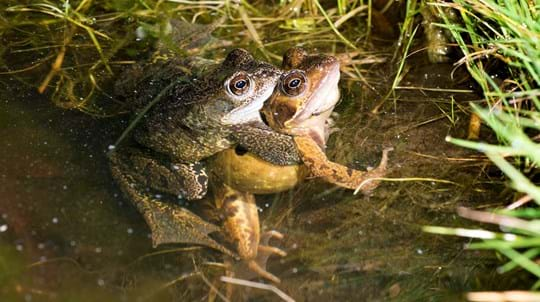
Blog
Life cycle of a frog: how do amphibians reproduce?
Rachel Hoskins • 09 Apr 2019

Digital Content Manager
Spring is the perfect time to spot frogs and toads in the UK as they hop out of hibernation and into their breeding pools to mate. But how do you tell the difference between a frog and a toad?
While these little amphibians might look similar at first glance, there are some key differences that tell them apart – from their skin and the way they move, right down to frog and toad spawn. Read on to find out the differences between frogs and toads.
British frogs have sleek, smooth skin that usually looks wet, even when they’re out of water. Their legs are longer than their head and body and are perfect for jumping – their preferred method of getting around. Frogs are also lithe and athletic looking, with a pointed nose.
Unlike frogs, British toads have bumpy, warty-looking skin that’s virtually always dry. They also have much shorter legs than frogs and prefer to crawl around rather than hop. Toads are quite squat and dumpy, with a much broader nose than the frog.
Female frogs and toads both release spawn (eggs) when they breed. Luckily, the difference between frog and toad spawn is easy to see: frog spawn is laid in gooey clumps, whilst toad spawn floats in stringy lengths. You’ll usually spot toad spawn wrapped around vegetation in slightly deeper water.
The difference between frog and toad tadpoles is a little harder to see at first. Like the adults, frog tadpoles are slimmer, whereas toad tadpoles are chunky. Frog tadpoles are also covered in gold flecks, while toad tadpoles are plain black in colour.
Where you find an amphibian can help you decide whether it’s a frog or a toad.
If it’s making its way along a pavement or ambling through some grass, chances are it’s a toad. They cope much better with dry conditions than frogs as their skin is more waterproof. Frogs lose moisture a lot more easily and so are more likely seen close to water, which explains why they always look moist. It isn't unusual, however, to see a frog some way from water, where they may seek refuge in damp places like log piles.
The Nature’s Calendar project tracks the effects of weather and climate change on wildlife across the UK – its records date all the way back to 1736! First frogspawn is among over 150 wildlife events recorded for the project, so if you’ve spotted your first clump, we’d love to know.

Help monitor the effects of climate change on wildlife near you. Your records contribute to a growing body of evidence on global warming.
Add your wildlife recordings